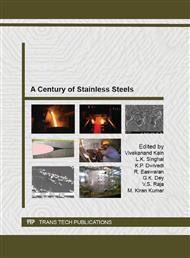p.449
p.460
p.468
p.476
p.484
p.493
p.502
p.507
p.517
Improvement in Welding of Austenitic Stainless Steel Thick Pipe: Metallurgical, Mechanical & Full Scale Pipe Weld Tests
Abstract:
The paper aims at demonstration of reduction in residual stress, distortion and sensitisation in austenitic stainless steel pipe welds. The welding processes considered are Gas Tungsten Arc Welding (GTAW) and Shielded Metal Arc welding (SMAW) along with Hot wire GTAW with narrow gap welding technique. It was shown that residual stress is significantly reduced in case of hot wire GTAW. The reduction in residual stress is due to the low heat input and high deposition rate. Lower heat input leads to higher cooling rate giving more margins on sensitization in heat affected zone (HAZ). This has been confirmed by measuring temperature and cooling rate during welding in HAZ of the weld joints. Susceptibility to sensitization of the welds has been compared by carrying out ASTM E262 Practice A and E along with Electo-Potentiokinetic Reactivation (EPR) method. The results of the tests show that values are within acceptable limit for both the cases. However, hot wire GTAW has marginally better sensitization resistance. Fatigue crack growth rate and fracture resistance behavior of the above mentioned weld joints have been compared by carrying out tests on the specimens (Compact Tension) and full scale pipe welds with crack. Fatigue crack growth rate and fracture toughness of the weld joints (hot wire GATW) is superior to conventional GTAW and SMAW. The paper presents the details of the above mentioned studies.
Info:
Periodical:
Pages:
484-492
Citation:
Online since:
September 2013
Authors:
Price:
Сopyright:
© 2013 Trans Tech Publications Ltd. All Rights Reserved
Share:
Citation:


